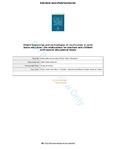(C)old beginnings and technologies of rectification in early years education: the implications for teachers and children with special educational needs
| dc.contributor.author | Done, Elizabeth | |
| dc.contributor.author | Andrews, Mandy | |
| dc.contributor.author | Evenden, C | |
| dc.date.accessioned | 2018-11-10T17:40:09Z | |
| dc.date.accessioned | 2018-11-12T12:30:11Z | |
| dc.date.issued | 2022-04-03 | |
| dc.identifier.issn | 0966-9760 | |
| dc.identifier.issn | 1469-8463 | |
| dc.identifier.uri | http://hdl.handle.net/10026.1/12767 | |
| dc.description.abstract |
This paper considers varied governmental initiatives in England and their implications for early years education, including: an Office for Standards in Education (2017. Bold Beginnings: The Reception Curriculum in a Sample of Good and Outstanding Primary Schools. Manchester: Ofsted) report entitled ‘Bold beginnings’ proposing curriculum changes in Reception teaching based on identified features of a small number of ‘good’ and ‘outstanding’ schools; Department of Education (2014. Early Years: Guide to the 0–25 SEND Code of Practice. London: DfE) advice for early years providers on special educational needs; and proposals from the same department for a single statutory baseline test in Reception. All assume a linear model of child development conceived as ‘progress’ and reflect moves to codify all aspects of child learning and early years professional practice. An alternative view of early years education drawn from poststructuralism is suggested here that affords more scope for intuitive practice and professional judgement in a child-centred approach. | |
| dc.format.extent | 434-447 | |
| dc.language | en | |
| dc.language.iso | en | |
| dc.publisher | Taylor & Francis (Routledge) | |
| dc.relation.replaces | http://hdl.handle.net/10026.1/12753 | |
| dc.relation.replaces | 10026.1/12753 | |
| dc.relation.replaces | 10026.1/12455 | |
| dc.relation.replaces | http://hdl.handle.net/10026.1/12455 | |
| dc.subject | Pediatric | |
| dc.subject | 4 Quality Education | |
| dc.title | (C)old beginnings and technologies of rectification in early years education: the implications for teachers and children with special educational needs | |
| dc.type | journal-article | |
| dc.type | Journal Article | |
| plymouth.issue | 2 | |
| plymouth.volume | 30 | |
| plymouth.publication-status | Published | |
| plymouth.journal | International Journal of Early Years Education | |
| dc.identifier.doi | 10.1080/09669760.2018.1547633 | |
| pubs.merge-from | 10026.1/12455 | |
| pubs.merge-from | http://hdl.handle.net/10026.1/12455 | |
| plymouth.organisational-group | /Plymouth | |
| plymouth.organisational-group | /Plymouth/Faculty of Arts, Humanities and Business | |
| plymouth.organisational-group | /Plymouth/Faculty of Arts, Humanities and Business/Plymouth Institute of Education | |
| plymouth.organisational-group | /Plymouth/REF 2021 Researchers by UoA | |
| plymouth.organisational-group | /Plymouth/REF 2021 Researchers by UoA/UoA23 Education | |
| plymouth.organisational-group | /Plymouth/Users by role | |
| plymouth.organisational-group | /Plymouth/Users by role/Academics | |
| dcterms.dateAccepted | 2018-10-04 | |
| dc.rights.embargodate | 2020-5-15 | |
| dc.identifier.eissn | 1469-8463 | |
| dc.rights.embargoperiod | Not known | |
| rioxxterms.versionofrecord | 10.1080/09669760.2018.1547633 | |
| rioxxterms.licenseref.uri | http://www.rioxx.net/licenses/all-rights-reserved | |
| rioxxterms.type | Journal Article/Review |



